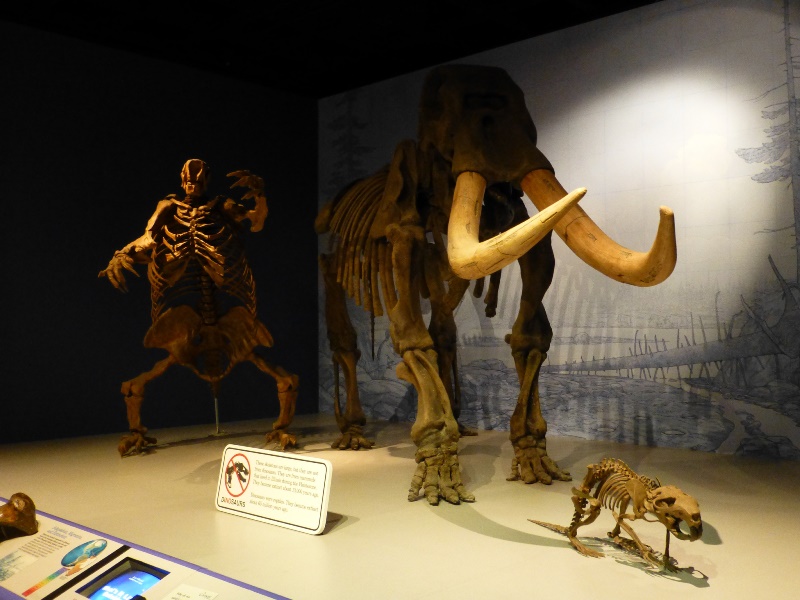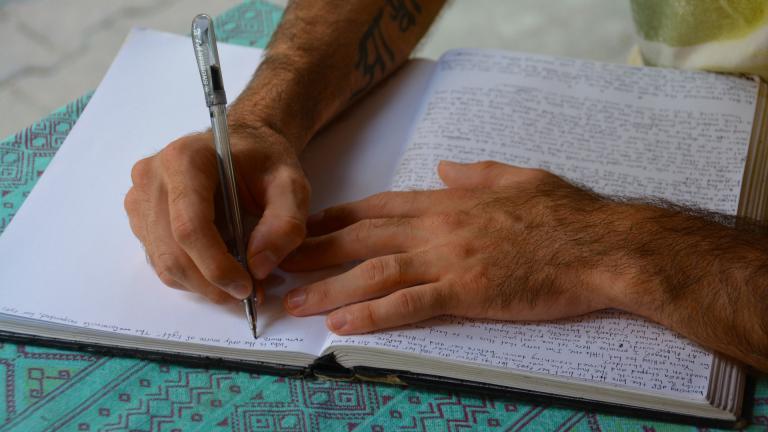 A mastodon fossil at the now closed Illinois State Museum (Flickr / Mike Linksvayer)
A mastodon fossil at the now closed Illinois State Museum (Flickr / Mike Linksvayer)
When the state of Illinois closed its museums over a month ago, it forgot one small detail: to stop paying museum employees.
But the state didn’t forget as much as it got caught up in a conundrum. In June, facing a $6 billion budget deficit, Gov. Bruce Rauner announced that $6.3 million could be saved via the closing of a small network of state facilities, including two museums and three art galleries.
Of course, that was before the labor unions sued the state of Illinois in September, arguing that Rauner’s decision directly violated their contracts. The governor acquiesced, and union museum workers still report for duty – now there’s just no public to reap the benefits.
Since union workers are at least temporarily allowed to keep their jobs, that means the state still has to pay their salaries. And so far, the governor’s office has been mum as to how this affects its initial projection of $6 million in savings.
The facilities, which closed Sept. 30, include the Dickson Mounds Museum in Lewiston and three art centers, in addition to a shooting complex in southern Illinois and Springfield’s Illinois State Museum, a 138-year-old institution home to the world’s largest collection of mastodon fossils.
It’s the Illinois State Museum, which has a grassroots group lobbying for its reopening, that’s arguably been hit hardest by the closures. Last month, as a direct result of the state’s decision, the American Alliance of Museums placed the museum on probation – meaning it now stands to lose its accreditation, the highest mark of distinction in the museum field and one the museum’s claimed since 1972.
Losing accreditation is a rare event in the museum world, according to Burt Logan, the chair of the Accreditation Commission for the American Alliance of Museums.
“The museum’s collection of artifacts really needs to be properly stored and cared for. They’re not just something that can be locked away and left indefinitely without damage occurring,” Logan said. “But the commission’s real concern is the fact that this wonderful educational resource is not being made available to the people of Illinois. We certainly hope a resolution will be found soon.”
As a result of the closings, 10 of the Illinois State Museum’s managerial workers were let go and another six retired, according to Illinois Department of Natural Resources spokesman Chris Young. Of the remaining staff, 43 union employees have stayed on to maintain artifacts and manage collections.
“I can’t see why we’re doing it. If you keep the majority of employees employed, why are you locking the doors? I have no idea,” said Guerry Suggs, board chairman of the Illinois State Museum, who estimates the closures are only saving the state some $400,000 annually.
When asked exactly how much the state was saving now that union employees continue to work, the governor’s office could not provide specific figures. The union lawsuits are still pending.
 Republican Gov. Bruce Rauner
Republican Gov. Bruce Rauner
In August, a bill passed through the Illinois Senate that would reopen the museums, effective immediately. But it remains to be seen whether the bill has enough bipartisan support to pass through the House.
Suggs said he’s hopeful the bill will get called when the House reconvenes on Nov. 10. Rep. Emily McAsey (D-Ill.), the bill’s chief House sponsor, said she doesn’t believe the state’s million-dollar savings estimate – conversely, she said the closings are actually having a huge economic impact on their respective townships.
“I’m so dismayed that these facilities which are taxpayer funded are closed to the public. Even closed, these operations are quite costly,” said McAsey, who said it’s her understanding that operating costs for the Lockport Gallery – one of the shuttered facilities in her district – come to just under $200,000 annually. Likewise, Guerry Suggs has estimated the museum system brings in some $30 million in annual tourism dollars.
McAsey, a former middle-school teacher, said she used to take students on field trips to Lockport.
“I know firsthand as an educator about the value of this museum to our schoolchildren. To lose that experience, a very accessible art gallery right here in the community – it’s beyond words how disappointing that is,” she said.
Offices for both House Speaker Michael Madigan and the governor continue to cast blame on one another regarding the museum closures, with Rauner spokeswoman Catherine Kelly pointing to the “majority party’s refusal to compromise,” and Madigan spokesman Steve Brown saying the governor could have avoided the closures himself via a line item veto in May.








